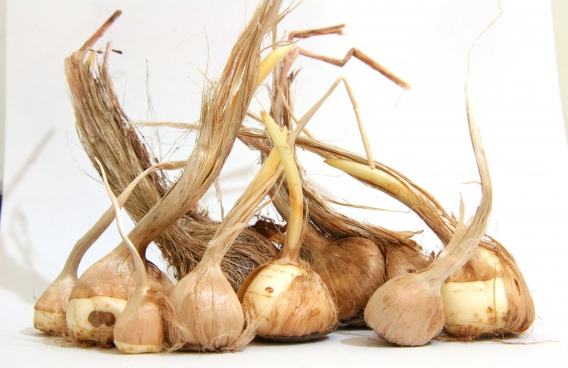Unisafarms | What factors determine the quality of saffron onion

Saffron onion quality is one of the most important factors affecting saffron flowering. The important role of saffron onion can not be separated from the quality of saffron, and for this reason, before planting saffron and preparing onions, we must first get acquainted with saffron onion and know the characteristics of a quality onion. Follow us to tell you more about the quality of saffron onions.
Saffron onion and its propagation method
Saffron onion is called mother onion and the onions that are propagated from it are called daughter onions. In fact, it is the mother onion that begins to multiply during the waking and growing season, from which the daughter onions are produced. After that, the onions begin to eat each other and form smaller onions. For this reason, the onions that are selected for planting are usually larger than hazelnuts and smaller than walnuts and weigh more than eight grams. These onions are not rotten and their terminal buds are perfectly healthy.
After planting saffron bulbs in the soil, these bulbs can remain in the soil for up to 10 years and from the seventh year onwards begin to multiply and produce small and dense bulbs. For this reason, farmers usually plant three- or four-year-old onions in the soil, which are both larger and produce a better crop and reproduce after a few years.
After this time, the onions should be removed from the soil. To bury them, you must first wait until the leaves of the saffron plant are completely dry, then the saffron bulbs are removed from the soil in two ways: drying and weeding. In the drier method with the help of a shovel or miner and in the Turkish onion method after irrigation and watering (over-irrigation of the ground), the bulbs are removed from the soil.
In the drying method, the onions are dry and can be stored in dry and ventilated warehouses and planted again in the desired season. However, in the Turkish onion method, the onions are wet and wet onions can not be stored, but must be replanted quickly in the soil.
Saffron onion quality and its characteristics
Saffron onion is the main factor in the growth and development of the saffron plant. Therefore, the quality of saffron onions is also very important. A good onion should be perfectly healthy, without scratches and rot, and should not have any diseases, fungi or mites. After onion health, the shape and size of saffron onions are important for planting quality saffron. Because the efficiency of saffron production depends entirely on the weight and size of the onion. As we have said, farmers usually choose three- to four-year-old onions for cultivation, which are larger.
In general, the shape of saffron onion can be round or oval. The weight of onions also depends on the type of cultivation method. Greenhouse onions weigh about 15 to 30 grams and traditional onions weigh about 8 to 15 grams.
The best weight for farmers is a balanced and medium weight, because if it is too big or small, it can negatively affect the yield and flowering of saffron. The average weight of saffron between 8 to 13 grams will be the best choice, because from the third year onwards, it will increase the yield by 50%. (Source)
It is interesting to know that after a few years, the weight of onions increases and this increase in weight and size increases flowering, which is why choosing a medium size and weight at the beginning of cultivation is very important.
Also, the quality of saffron onion, in addition to its weight and shape, can be checked with a health license from the Plant Protection Organization. This license identifies reputable saffron onion breeders and checks the onions for quality, so you can trust the quality of the saffron onion.
Saffron onion and its role in quality saffron
Numerous factors affect the harvest of quality saffron, from climate to soil type, irrigation conditions and onions. Perhaps the most important reason for growing high-quality saffron is its onion. Because saffron flowers are sterile and do not produce seeds themselves, but it is the saffron onion that is considered effective on the growth and development of saffron flowers.
If saffron onion is not irrigated properly, the quality of saffron will still be affected. In general, the role of saffron onion can not be separated from its quality.
It is better to disinfect the onions before planting to ensure the quality of saffron onions and finally the final product. For disinfection, you can use Sarzan, Tritizan and Graminon and remove the onion fibers and flakes before planting. Because they absorb water better and germinate faster.
Also note that saffron onions have a certain period of sleep and growth, and if the planting time is wrong, it can affect the crop. According to the growth structure of onions, the best time to cultivate saffron is June, because June is the dormant period of onions, and thus onions give a more productive crop in the first year. But if the soil is not ready for planting at this time, mid-August to September can be a good choice.
Last word
To harvest a good saffron, do not forget the quality of saffron onions. When buying and preparing saffron onion, pay attention to its health and when planting, pay attention to its special conditions and needs so that you can harvest high-yielding and high-quality products.